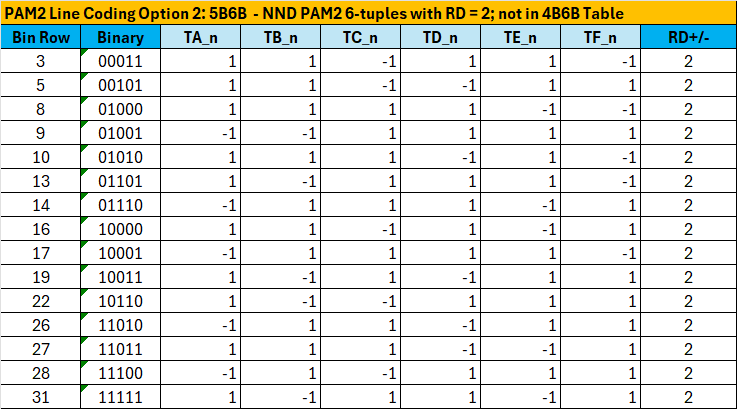Hi Brian,
Thanks for the information. I need some time to do the simulation and check the feasibility.
Best wishes,
Tingting
发件人: Murray, Brian <Brian.Murray@xxxxxxxxxx>
发送时间: 2024年12月24日 2:53
收件人: STDS-802-3-SPEP2P@xxxxxxxxxxxxxxxxx
主题: [802.3_SPEP2P] Table of 4B6B NND 6-tuples with maximum running disparity of +2
Tingting
Just to follow up on our conversation at the December Adhoc.
As I have said at the last meeting as far as I can see from my simulations your proposed table of 4B6B NND 6-tuples is well behaved with no significant concern over data correlation. The adjustment
in mse from PAM2 to PAM3 is generally small < 0.5 dB. With some case of an adjustment closer to 1 dB.
You have one entry in the table with a running disparity of +4. This results in a range of running disparity for PAM2 training using your table of 4B6B is ± 7. The range of running disparity for PAM3
8B6T coding during data / idle is ± 5. I think it would be cleaner, if the running disparity for training and data were both ± 5.
In your presentation to the October Adhoc, you presented a table of 16 entires, 4B6B and a table 32 entries 5B6B. Thus, there are 14 additional 6-tuples with running diparity of +2 and their inverse
available to use as alternative 6-tuples in the 4B6B table.
I have tries a few of these and as far as I can see they are well behaved any one of these 14 possible 6-tuples could replace the 6-tuple of running disparity +4 in your 4B6B table.

Brian
To unsubscribe from the STDS-802-3-SPEP2P list, click the following link:
https://listserv.ieee.org/cgi-bin/wa?SUBED1=STDS-802-3-SPEP2P&A=1
To unsubscribe from the STDS-802-3-SPEP2P list, click the following link: https://listserv.ieee.org/cgi-bin/wa?SUBED1=STDS-802-3-SPEP2P&A=1